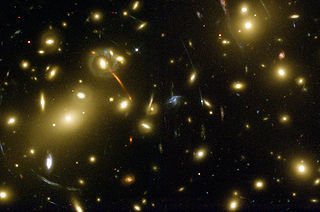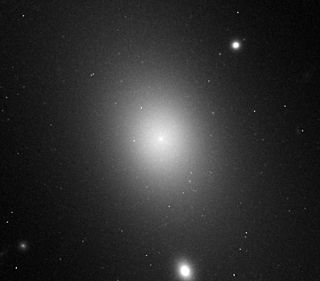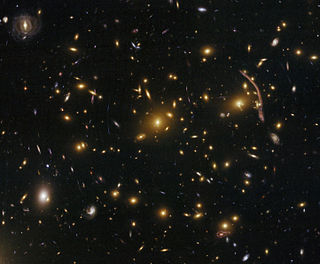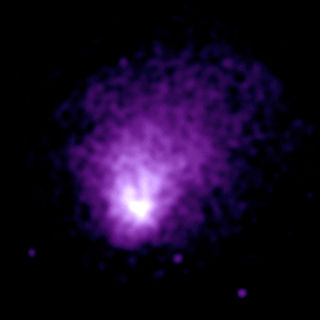
Abell 2218 is a large cluster of galaxies over 2 billion light-years away in the constellation Draco.
Abell 754 is a galaxy cluster in the constellation Hydra that was formed from the collision of two smaller clusters. This collision, which began about 300 million years ago, is ongoing, and the system is still disturbed. Eventually, the cluster will reach a level of equilibrium in a few billion years.

Abell 2029 or A2029 is a large and relaxed cluster of galaxies 315 megaparsecs away in the constellation Virgo. A2029 is a Bautz–Morgan classification type I cluster due to its large central galaxy, IC 1101. Abell 2029 has a diameter of 5.8–8 million light-years. This type of galaxy is called a cD-type brightest cluster galaxy and may have grown to its large size by accreting nearby galaxies. Despite its relaxed state, it is the central member of a large supercluster which shows clear signs of interaction.

IC 1101 is a class S0 supergiant (cD) lenticular galaxy at the center of the Abell 2029 galaxy cluster. It has an isophotal diameter at about 123.65 to 169.61 kiloparsecs. It possesses a diffuse core which is the largest known core of any galaxy to date, and contains a supermassive black hole, one of the largest discovered. The galaxy is located at 354.0 megaparsecs from Earth. The galaxy was discovered on 19 June 1790, by the British astronomer William Herschel.
Abell 3266 is a galaxy cluster in the southern sky. It is part of the Horologium-Reticulum Supercluster. The galaxy cluster is one of the largest in the southern sky, and one of the largest mass concentrations in the nearby universe.

Abell 370 is a galaxy cluster located nearly 5 billion light-years away from the Earth, in the constellation Cetus. Its core is made up of several hundred galaxies. It was catalogued by George Abell, and is the most distant of the clusters he catalogued.

Abell 2163 is one of the richest and most distant of the clusters of galaxies found in the Abell catalogue. Its abell richness class is 2 and position is at a redshift z=0.2. Data from Chandra X-ray Observatory have shown that it is the hottest galaxy cluster in the Abell catalogue. It is also a merging cluster.

Abell 2199 is a galaxy cluster in the Abell catalogue featuring the brightest cluster galaxy NGC 6166, a cD galaxy. Abell 2199 is the definition of a Bautz-Morgan type I cluster due to NGC 6166.

Abell 383 is a galaxy cluster in the Abell catalogue.

Abell 2147 is a galaxy cluster in the Abell catalogue. It is located within the core of the Hercules Superclusters, within Serpens Caput, near the cluster Abell 2152, approximately two degrees south southwest of the Hercules Cluster. It is possible that Abell 2147 is actually part of the Hercules Cluster considering that it shares the same redshift of 550 million light years.
Abell 133 is a galaxy cluster in the Abell catalogue.

Abell 262 is a galaxy cluster in the Abell catalogue. It is part of the Perseus–Pisces Supercluster, one of the largest known structures in the universe. Although its central galaxy, NGC 708, is a giant cD galaxy, most of its bright galaxies are spirals, which is unusual for a galaxy cluster. With approximately 200 members it is a comparatively small cluster.
Abell 478 is a galaxy cluster listed in the Abell catalogue.
Abell 907 is a galaxy cluster in the Abell catalogue.

Abell 1413 is a massive and rich type I galaxy cluster straddling the border between the constellations Leo and Coma Berenices, with the projected comoving distance of approximately 640 Mpc (2.1 billion ly). The cluster is especially notable due to the presence of its very large brightest cluster galaxy (BCG), one of the most extreme examples of its type, as well as one of the largest galaxies known. The cluster was first noted by George O. Abell in 1958.
Abell 1795 is a galaxy cluster in the Abell catalogue.
Abell 1991 is a galaxy cluster in the Abell catalogue.

Abell 665 is a galaxy cluster in the Abell catalogue in the constellation Ursa Major. It is also known as the only cluster in his 1989 catalog to receive Abell's highest richness class of 5. This means that it contains at least 300 galaxies in the magnitude range of m3 to m3+2, where m3 is the magnitude of the third-brightest member of the cluster. The clusters in all other richness classes contain less than 300 such galaxies. Abell 665's combination of high brightness and large distance, made it an excellent candidate along with 37 other clusters to help determine the Hubble constant using the Sunyaev–Zel'dovich effect in 2006.
Abell 2152 is a bimodal galaxy cluster and one of three clusters comprising the Hercules Supercluster. It contains 3 BCGs; the S0 lenticular UGC 10204, the pair UGC 10187, and the SA0 unbarred lenticular CGCG 108-083. In total there are 41 galaxies which are confirmed to be members of the cluster. The cluster is classified as a Bautz-Morgan type III and Rood-Sastry class F cluster, indicating morphological irregularity and perhaps dynamical youth. It is receding from the Milky Way galaxy with a velocity of 12385 km/s.











